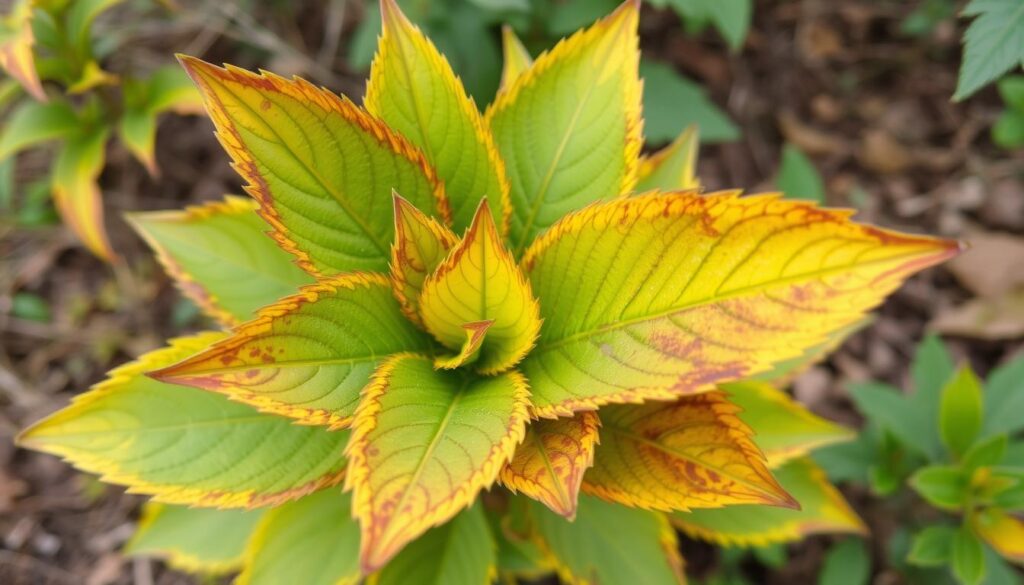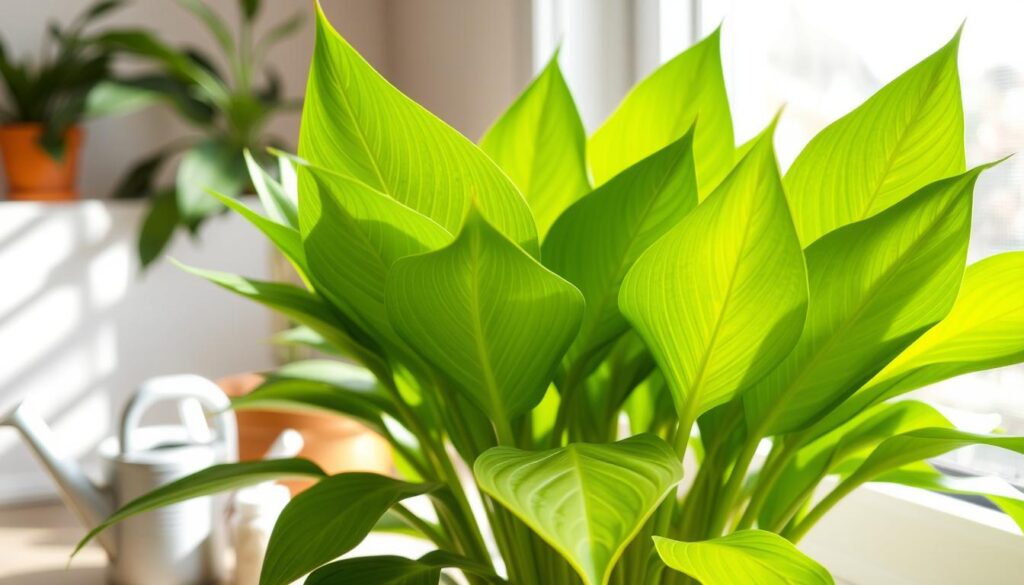The arrowhead plant, also known as Syngonium, is a favorite among houseplant lovers. It’s known for its stunning leaves and easy care. But, many owners face the problem of Arrowhead plant turning yellow leaves. This can happen due to too much water, not enough water, bad light, or missing nutrients.
About 60% of yellow leaves in arrowhead plants come from too much or too little water. Keeping the soil just right is key. Wait until 50% of the soil is dry before watering. Knowing why leaves turn yellow helps you care for your plant better and avoid more damage.
Table of Contents
Understanding the Arrowhead Plant
The arrowhead plant, also known as syngonium, comes from tropical areas in Central and South America. It’s famous for its heart-shaped leaves and thrives in humid places. Knowing what your arrowhead plant needs is key to caring for it well.
These plants love bright, indirect light but can handle low light too. They grow best in temperatures between 15°C (60°F) and 29°C (85°F). This makes them perfect for indoor spaces.
What is an Arrowhead Plant?
An arrowhead plant belongs to the Arum family and has unique, arrowhead-shaped leaves. It can grow well in different light conditions. With the right care, it can quickly become a beautiful part of any room.
Common Varieties of Arrowhead Plants
There are many types of arrowhead plants, each with its own look and growth pattern. The syngonium podophyllum and syngonium macrophyllum are two popular ones. Knowing your plant’s specific needs helps prevent problems like yellow leaves.
Understanding your arrowhead plant’s needs lets you care for it properly. This way, you can enjoy its beautiful leaves for a long time. Whether you’re new to gardening or experienced, the arrowhead plant is a great choice for adding greenery to your home.
| Arrowhead Plant Variety | Characteristics |
|---|---|
| Syngonium Podophyllum | Heart-shaped leaves, fast growth rate |
| Syngonium Macrophylum | Large, arrowhead-shaped leaves, slow growth rate |
Signs of Trouble: Yellowing Leaves
Yellowing leaves can signal trouble in arrowhead plants. It’s key to find out why to fix the problem. Overwatering is a common cause, leading to root rot and other issues. Water only when the top 50% of soil feels dry.
Underwatering, nutrient deficiencies, and temperature stress can also cause yellow leaves. Yellow leaves can also be a natural part of the plant’s life cycle, as older leaves turn yellow and fall off. But, if many leaves turn yellow or show other signs, it might be a bigger problem.
Signs of overwatering include bright yellow leaves and wet, muddy soil. Underwatering makes leaves limp and droopy.
| Cause | Symptoms |
|---|---|
| Overwatering | Bright yellow leaves, wet and muddy soil, blackened stem bases |
| Underwatering | Leaves turning limp and droopy |
To stop yellow leaves, give your arrowhead plant the right care. This includes proper watering, humidity, and temperature. By fixing the cause of yellow leaves, your plant can stay healthy and look great.
Common Causes for Yellowing
When your arrowhead plant turns yellow, consider the common reasons like overwatering and underwatering. Too much water often leads to root rot, causing yellowing leaves that eventually fall off. On the other hand, underwatering makes leaves dry and crispy, turning yellow and brown.
Checking out Syngonium care guides can provide valuable tips for addressing issues like your arrowhead plant turning yellow. These guides show how to balance water, light, and nutrients effectively. Since overwatering is a major culprit, learning proper watering techniques is key to avoiding yellow leaves.
Poor lighting is another factor to watch out for. Arrowhead plants turning yellow can result from insufficient light—these plants thrive in bright, indirect light. Nutrient deficiencies, such as a lack of nitrogen, iron, or magnesium, may also cause yellow leaves. By observing your plant closely and making necessary adjustments, you can resolve these issues and restore your plant’s health.
Here are some tips to stop yellow leaves:
- Water when the top 50% of the soil is dry to avoid too much water.
- Keep a regular watering schedule to prevent too little water.
- Make sure your plant gets enough, indirect light for healthy growth.
- Fertilize with a balanced NPK fertilizer every 4-6 weeks when it’s growing.
Diagnosing the Problem of Arrowhead plant turning yellow
When your arrowhead plant’s leaves turn brown, it’s important to find the cause. This could be due to root rot from too much water. Start by checking the plant’s environment, like temperature, humidity, and light.
Also, look at how you water the plant. It needs consistent moisture, not too dry or too wet. Learning about proper plant care helps understand what your arrowhead plant needs. It likes bright, indirect light and temperatures between 65 and 75 degrees Fahrenheit.

Checking the soil can also help. If the plant gets too much water, it can rot, causing leaves to turn dark brown or black. Finding the problem helps you fix it and keep your plant healthy.
Some important things to check include:
- Soil moisture levels
- Light exposure
- Temperature
- Humidity
- Watering habits
By looking at these factors and making changes, you can solve the problem. This helps your arrowhead plant stay healthy and prevents leaves from turning brown.
Solutions for Overwatering
Arrowhead plants often die from too much water. To fix this, you need to change how often you water and make sure the soil drains well. Start by repotting the plant in fresh soil and check the roots for rot. This helps the plant heal and grow strong again.
Here are some important steps to fix overwatering:
- Repot the plant in soil that drains water well to avoid waterlogging
- Look at the roots for rot and cut them if you find any
- Change the watering schedule so the soil can dry a bit between waterings
By following these steps, you can help your arrowhead plant get better from too much water. Keep an eye on your plant and adjust its care as needed. This way, you can avoid arrowhead plant dying from too much water. Using overwatering solutions like better drainage and a smart watering schedule can really help.
| Common Issue | Solution |
|---|---|
| Overwatering | Repot in well-draining soil, adjust watering schedule |
| Root Rot | Inspect and trim roots, improve drainage |
Solutions for Underwatering
Underwatering can make syngonium yellow leaves droop and turn yellow. If the soil is very dry, it’s time to water. To fix underwatering, you need to water your plant right. Check the soil moisture by sticking your finger in or using a moisture meter.
Some key underwatering solutions include:
- Watering thoroughly, making sure the soil is moist but not waterlogged
- Adjusting the watering schedule to ensure the soil doesn’t dry out completely
- Using a well-draining potting mix to prevent water from accumulating in the soil
By giving the right amount of water, your arrowhead plant can recover. Regular checks and care can also stop yellow leaves. With the right care, your syngonium plant will stay healthy and look great.
Remember, fixing underwatering is key to keeping your plant healthy. Follow these tips and stay alert to keep your syngonium yellow leaves looking good.
The Importance of Lighting
Arrowhead plants, also known as syngonium, need the right light to stay healthy. If their leaves turn yellow, it might mean they’re not getting enough light. These plants do best in medium to bright light.
It’s key to give them the right amount of light. Too much direct sunlight can burn their leaves. Not enough light can make them grow too long and weak. To keep your plant happy, make sure it gets the light it needs.
Identifying Light Requirements
To find the best light for your arrowhead plant, think about a few things:
- How far it is from the light source
- How strong the light is
- How long it’s exposed to light
Adjusting Placement for Optimal Growth
Put your arrowhead plant in a spot with bright, indirect light. Stay away from direct sunlight, especially when it’s strongest. This will help your plant grow well and avoid yellow leaves.
Nutrient Needs of Arrowhead Plants
Arrowhead plants need a mix of nutrients to grow well. Nutrients like nitrogen, iron, and magnesium are key for green leaves. If these are missing, arrowhead plant leaves turning yellow can happen. Fertilizing helps fix these issues.
Gardening experts say nitrogen issues start with yellow lower leaves. Iron is also vital for chlorophyll production. Fertilize your plant monthly from mid-February to October to meet its nutrient needs.
For more tips on caring for your arrowhead plant, Knowing what your plant needs and fertilizing right can help it grow strong. This way, you can avoid problems like arrowhead plant leaves turning yellow.

Here are some important tips for fertilizing your arrowhead plant:
* Fertilize once a month during the growing season
* Use a balanced fertilizer with nitrogen, iron, and magnesium
* Don’t overfertilize, as it can harm your plant
* Watch how your plant reacts to fertilizers and adjust as needed
| Nutrient | Importance |
|---|---|
| Nitrogen | Promotes healthy foliage growth |
| Iron | Helps produce chlorophyll |
| Magnesium | Supports overall plant health |
Preventative Measures to Keep Leaves Green
Regular pruning is key for your Arrowhead Plant’s health. Cutting off sad, yellowed, or dead leaves gives it a new start. This is part of arrowhead plant care and helps nutrients go to growth. With preventative measures like regular watering, fertilizing, and pruning, you can stop yellowing leaves.
To keep your Arrowhead Plant healthy, take these preventative measures:
- Water only when the top inch of soil feels dry to the touch.
- Use a well-draining soil mix to prevent overwatering.
- Place the plant in bright, indirect light to avoid excessive sun exposure.
- Use a balanced, water-soluble fertilizer during the growing season.
By following these preventative measures and adding them to your arrowhead plant care routine, your plant will stay green. This will prevent yellowing leaves.
Remember, a well-cared-for Arrowhead Plant can thrive and beautify your space. With the right preventative measures and arrowhead plant care, you can enjoy its beauty.
| Preventative Measure | Benefit |
|---|---|
| Regular Pruning | Redirects nutrients, promotes growth |
| Proper Watering | Prevents overwatering, ensures healthy roots |
| Balanced Fertilization | Supports healthy growth, prevents nutrient deficiencies |
When to Seek Professional Help
If your arrowhead plant’s leaves keep turning yellow, even after trying everything, it’s time to get professional help. An arrowhead plant expert can help if you’ve changed how you water, light, and feed it, but the problem stays.
Signs you need an expert include leaves that keep wilting, root rot, or pests. These problems are hard to fix alone. An arrowhead plant expert can guide you to fix your plant’s health.
To find a good plant specialist, ask friends, family, or online forums. Look for local nurseries or gardening stores that offer professional help. Choose someone with arrowhead plant experience and a good reputation.

Getting professional help ensures your arrowhead plant gets the best care. It’s wise to seek advice from an arrowhead plant expert if you’re unsure about a problem.
Reviving Your Arrowhead Plant
This article has given you the tools to revive your arrowhead plant. You now know how to fix yellow leaves and keep your plant healthy. Remember, it takes time and effort for your plant to fully recover.
Final Tips for Success
Here are some final tips to help you:
- Watch your plant closely and fix problems fast.
- Keep watering, fertilizing, and lighting the same.
- Prune your plant often to keep it bushy and balanced.
- Get professional help if your plant’s problems don’t go away.
Celebrating a Healthy Plant
With the right care, your arrowhead plant will flourish. Share your success with others. It will inspire them to care for their plants too.
Frequently Asked Questions For Arrowhead plant turning yellow
What does an overwatered Arrowhead Plant look like?
An overwatered Arrowhead Plant often shows signs of yellowing leaves, soft or mushy stems, and wilting despite the soil being wet. The leaves may also turn brown and feel soggy to the touch. If the plant is severely overwatered, the roots may begin to rot, causing an unpleasant smell.
Can a yellowing plant be saved?
A yellowing plant can often be saved if the underlying issue is addressed. If the cause is overwatering, allow the soil to dry out completely and ensure proper drainage. For nutrient deficiencies or pest issues, adjust care accordingly by using appropriate fertilizers or treating for pests.
How to save a dying Arrowhead Plant?
To save a dying Arrowhead Plant, first, figure out why it’s dying. If it’s because of too much water, start watering less and let the soil dry out. Cut off any dead or yellow leaves to encourage new growth.
Make sure the plant gets enough light but not direct sunlight. If the roots are too tight, it might be time to repot. With the right care, your Arrowhead Plant can come back to life.
How often should you water an Arrowhead Plant?
Arrowhead Plants prefer their soil to dry out a bit between waterings. Water your plant when the top 1-2 inches of soil dry. Typically, this means watering every 7-10 days, but the frequency can vary based on your home’s humidity and plant size.
Why is my Arrowhead Plant turning yellow?
Yellowing leaves on an Arrowhead Plant can result from overwatering, nutrient deficiencies, too much direct sunlight, or pests. To diagnose the issue, check the plant’s watering schedule, light exposure, and soil quality.
How do you tell if a plant is dehydrated or overwatered?
Dehydrated plants often have dry, crispy leaves that turn brown at the edges. Overwatered plants show yellowing leaves, wilting, and soft, mushy stems. The key difference is that overwatered plants tend to have wet, soggy soil, while dehydrated plants have dry, crumbly soil.

